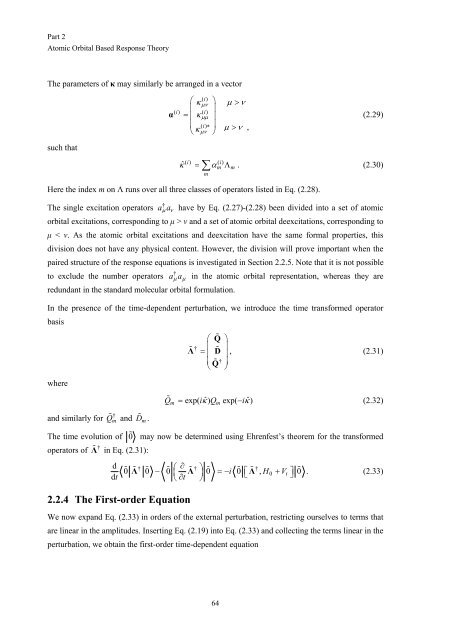Get my PhD Thesis
Get my PhD Thesis
Get my PhD Thesis
You also want an ePaper? Increase the reach of your titles
YUMPU automatically turns print PDFs into web optimized ePapers that Google loves.
Part 2<br />
Atomic Orbital Based Response Theory<br />
The parameters of κ may similarly be arranged in a vector<br />
such that<br />
⎛ ⎞ ><br />
() i<br />
κ µν µ ν<br />
⎜ ⎟<br />
() i () i<br />
= ⎜ κµµ<br />
⎟<br />
⎜ () i<br />
κ µ ν ,<br />
µν<br />
∗ ⎟ ><br />
α (2.29)<br />
⎝<br />
⎠<br />
ˆ() i ()<br />
κ = ∑ αm<br />
i Λm<br />
. (2.30)<br />
m<br />
Here the index m on Λ runs over all three classes of operators listed in Eq. (2.28).<br />
The single excitation operators a †<br />
µ aν have by Eq. (2.27)-(2.28) been divided into a set of atomic<br />
orbital excitations, corresponding to µ > ν and a set of atomic orbital deexcitations, corresponding to<br />
µ < ν. As the atomic orbital excitations and deexcitation have the same formal properties, this<br />
division does not have any physical content. However, the division will prove important when the<br />
paired structure of the response equations is investigated in Section 2.2.5. Note that it is not possible<br />
to exclude the number operators a †<br />
µ aµ in the atomic orbital representation, whereas they are<br />
redundant in the standard molecular orbital formulation.<br />
In the presence of the time-dependent perturbation, we introduce the time transformed operator<br />
basis<br />
⎛ Q<br />
⎞<br />
† ⎜ ⎟<br />
Λ<br />
= ⎜ D<br />
⎟ , (2.31)<br />
⎜ † ⎟<br />
⎝Q<br />
<br />
⎠<br />
where<br />
and similarly for<br />
†<br />
Q m and D m .<br />
Q = exp( iˆ<br />
κ) Q exp( −iˆ<br />
κ)<br />
(2.32)<br />
m<br />
The time evolution of 0 may now be determined using Ehrenfest’s theorem for the transformed<br />
†<br />
operators of Λ in Eq. (2.31):<br />
d † ∂<br />
0 0 0<br />
† 0 0<br />
†<br />
Λ −<br />
⎛<br />
Λ<br />
⎞<br />
= − ⎡ Λ , 0 + ⎤ 0<br />
dt<br />
2.2.4 The First-order Equation<br />
m<br />
<br />
⎜<br />
i H V<br />
∂t<br />
⎟<br />
<br />
⎣ t<br />
<br />
⎝ ⎠<br />
⎦ . (2.33)<br />
We now expand Eq. (2.33) in orders of the external perturbation, restricting ourselves to terms that<br />
are linear in the amplitudes. Inserting Eq. (2.19) into Eq. (2.33) and collecting the terms linear in the<br />
perturbation, we obtain the first-order time-dependent equation<br />
64

















